

William Stopford
Hyundai i30 N hot hatch sticking around, could get hybrid power – report
10 Days Ago
It may no longer be Hyundai's flagship in Australia, but the top-spec Santa Fe embodies the best of what the brand has to offer globally.
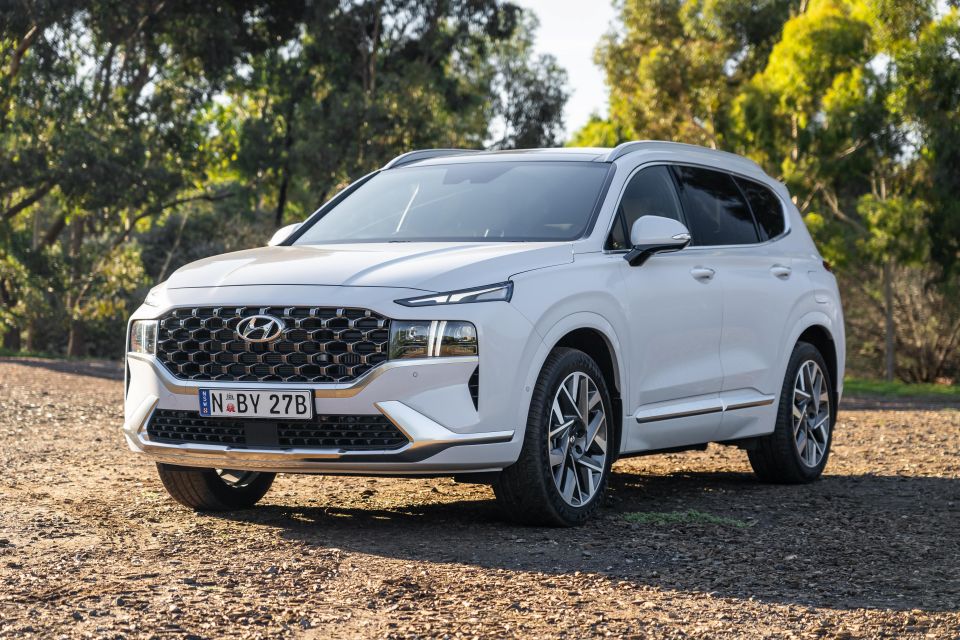


Marketplace Editor
New from
$65,200
excl. on-roads

Marketplace Editor
New from
$65,200
excl. on-roads


Marketplace Editor
New from
$65,200
excl. on-roads

Marketplace Editor
New from
$65,200
excl. on-roads
Quickly see how this car stacks up against its competition. Select any benchmark to see more details.
Where expert car reviews meet expert car buying – CarExpert gives you trusted advice, personalised service and real savings on your next new car.
The Hyundai Santa Fe is the Korean brand’s global flagship, even though it isn’t the biggest, baddest model you can get in Hyundai showrooms.
Because of this, the mid-life refresh for the seven-seat SUV was more major than your usual redesign. In actuality, it’s almost an entirely new car underneath.
Hyundai paired the facelift of the fourth-gen Santa Fe with the introduction of an all-new platform, allowing for more sophisticated technologies and the option for electrification – a hybrid and plug-in hybrid are offered globally, though only the former will make it to Australia later this year.
Here on test we have the diesel-powered 2021 Hyundai Santa Fe Highlander, the most expensive model in the range at just over $65,000 list.
Is it a worthy flagship for Hyundai?
On test we have the range-topping Highlander with a diesel engine and all-wheel drive, which lists at $65,200 before on-road costs.
According to Hyundai’s website, that works out to an estimated drive-away price of $70,541.
That puts the flagship Santa Fe in line with the Mazda CX-8 Asaki (from $62,790) and CX-9 Azami (from $66,190), as well as Hyundai’s own Palisade Highlander (from $71,000) and the all-new Toyota Kluger Grande (from $68,900).
Additionally, the related but slightly larger Kia Sorento in equivalent GT-Line Diesel AWD spec is listed as $67,290 drive-away – up from the original launch pricing of $64,990 drive-away.
The Santa Fe Highlander can also be cross-shopped against smaller premium seven seaters (more 5+2 seaters) such as the Land Rover Discovery Sport R-Dynamic D165 S (from $69,423) and Mercedes-Benz GLB250 4Matic (from $73,900).

Buy your new car without the stress. It's fast, simple and completely free.

Great service from Travis and team, second time I have used this business would not hesitate to recommend them to anyone
Craig C.
Purchased a Ford Ranger in Sunshine Coast, QLD
CarExpert helped Craig save thousands on his Ford Ranger, now let us save you on your next new car.
Find a dealThe Santa Fe Highlander gets the following exclusive features over lesser trims:

Specification carried over from lower grades includes:
The flagship Santa Fe doesn’t leave you wanting for much, and offers a number of high-end standard features that could cost you twice the price in an equivalently sized European luxury equivalent.
It’s also decked out with the latest Hyundai has to offer in terms of active safety and driver assistance, which we’ll get to in the next section.
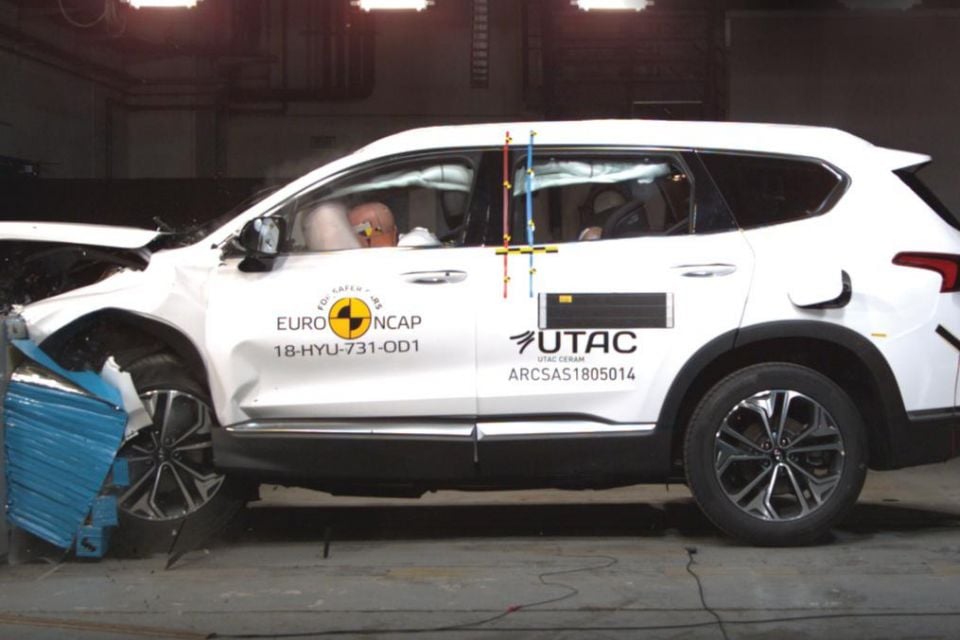
When the Hyundai Santa Fe was tested by ANCAP in 2018, it received a rating of five stars.
That rating was based on an adult occupant protection score of 94 per cent, child occupant protection of 86 per cent, pedestrian protection of 67 per cent and safety assist of 78 per cent.
The new Santa Fe won’t be re-tested.

All models come as standard with the following active safety features:
The range-topping Highlander on test adds a blind-spot camera view in the digital instrument binnacle, reverse autonomous emergency braking, and remote smart parking.
There are also front, front-side and curtain airbags for the first row, as well as curtain airbags for the second row. Like the related Kia Sorento, the Santa Fe’s curtain airbags unfortunately don’t extend to fully cover the third row.

Having now reviewed the new Santa Fe as well as the latest Kia Sorento, the Hyundai is my pick in terms of cabin quality and ambience.
Where its Kia sibling is more utilitarian and somewhat American in terms of the design and execution, the Santa Fe offers a greater proportion of soft-touch materials, stitched and padded leatherette surfaces beyond the seat trim, and a more cockpit-like dashboard layout.
Whether this appeals to you more is a matter of personal taste, but the Santa Fe’s front row feels more luxurious and befitting of the price tag compared to its Sorento stablemate.
Our test vehicle’s optional Camel Beige interior ($295) adds a splash of colour and visual pizazz over the standard black, though some might find it a bit garish.



Up front space and comfort are great, with supportive seats, good levels of adjustment for both the driver and front passenger, as well as plenty of storage options for your odds and ends.
The Santa Fe’s new button-heavy centre stack is a little busy and may not be to all tastes, and the door bins are shallow for what is a family vehicle likely to be tasked with holding large drink bottles and other bulky items.
As noted earlier, perceived quality is up there with the class leaders, though there are still some hard scratchy plastics in areas that are a harsh contrast to the nicer more padded surfaces in the cabin.
The new 10.25-inch widescreen infotainment system runs the Hyundai/Kia group’s latest interface, which is user-friendly, snappy to respond, and well featured – without the (buggy) wireless smartphone mirroring fitted to base models without factory navigation.
Likewise, the Highlander’s 10-speaker Harman Kardon premium audio system (shared with the Elite) offers crisp, clear sound with a good amount of depth for bassy tunes.
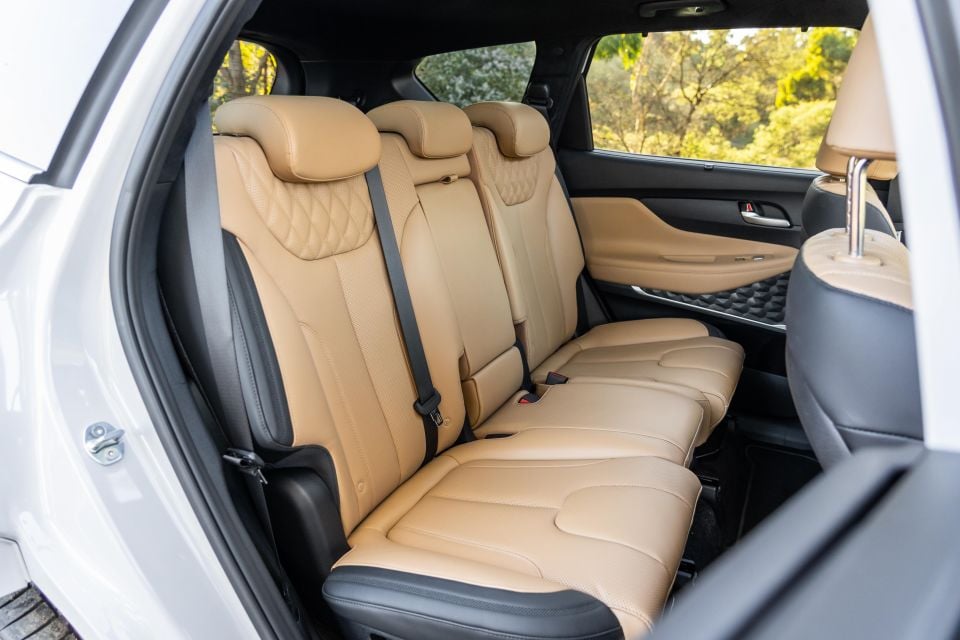

Being a luxurious family SUV, the second and third rows are arguably as important as the front. Thankfully, the Santa Fe largely delivers on all fronts.
There’s a good amount of space for two adults in the third row, and three can sit across for short journeys. The rear bench also slides and reclines, with a 60:40 split with the smaller part on the Australian kerb side.
Rear air vents are a nice inclusion, but the Palisade’s third zone of climate control would be even better. The outboard second-row seats are heated in this specification, too.
Beyond that, there’s well-sized map pockets on the front seat backs, two USB charge ports behind the centre console, as well as a sliding and reclining second-row bench. There’s a nifty limo-like seat adjust for the front passenger seat so you can liberate more legroom at the touch of a button from the driver’s seat or the back.
A fold-down rear centre armrest with cupholders rounds out the second-row amenities, unless you add in that panoramic sunroof that extends to almost the third row.

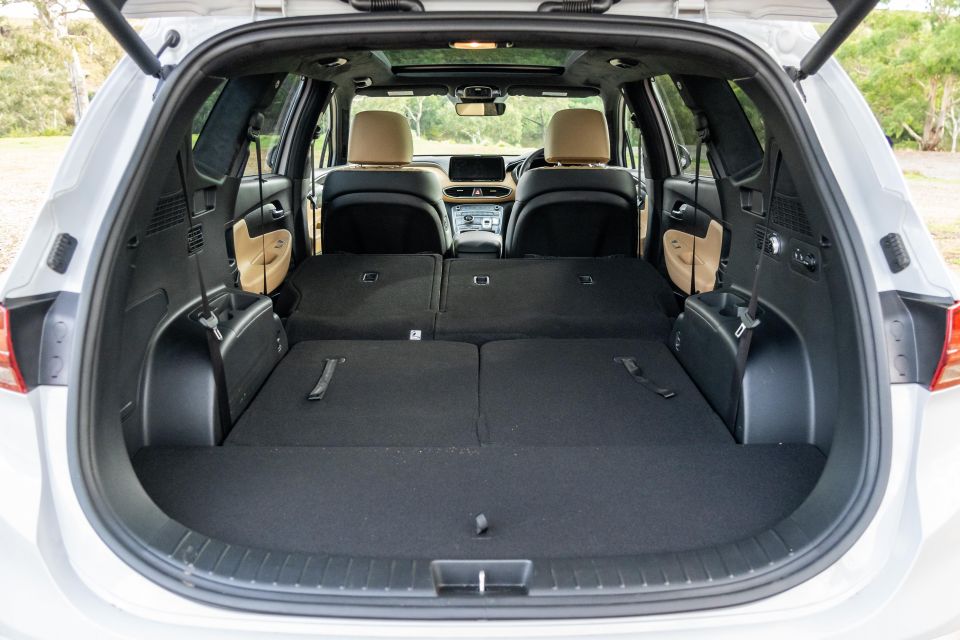
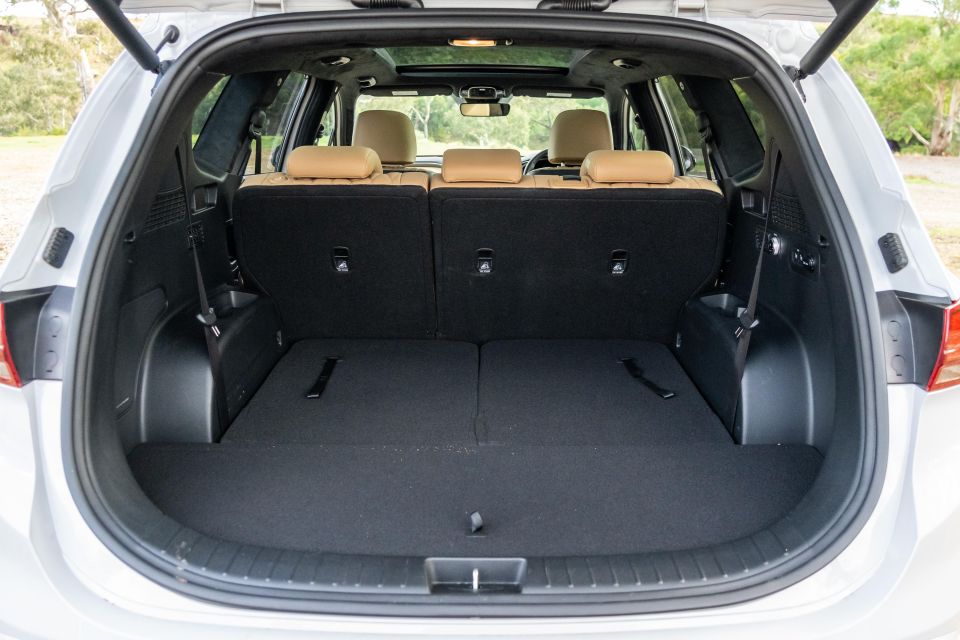
Speaking of the third row, a quick try squeezing my six-foot-one and 80-something kilo frame in there demonstrated the main advantage of opting for the larger Palisade. The Santa Fe’s rearmost seats are best left for kids, even with the second row slid forward.
For me there was very limited leg and knee room, while my head was wedged up against the (lovely) suede headliner. There’s separate AC controls for the third row passengers, as well as USB charge ports and cupholders.
With the third row in place, you have a small 130L of luggage capacity for soft bags or loose items. Folding the third row down liberates between 571 and 782 litres depending on how far forward the second row is slid, while the Santa Fe offers 1649L in two-seat configuration.
Unlike a lot of competitors, there’s a full-size alloy wheel under the boot floor.

On test we have the Santa Fe Highlander with the 2.2-litre four-cylinder turbo-diesel driving all four wheels via an eight-speed wet-type dual-clutch automatic.
Outputs for the revised engine are 148kW (@3800rpm) and 440Nm (@1750-2750rpm). While outputs are pretty much the same as the pre-facelift Santa Fe, the engine now uses a lighter aluminium block, which the company claims is 19 per cent more efficient than before.
The official fuel consumption claim is a miserly 6.1L/100km on the combined cycle.

During our time with the Santa Fe, we saw mid sevens to low eights with mixed driving, the latter with more urban driving.
While up on the claim, it’s not bad given the Santa Fe is a family-sized SUV and Australian models don’t fit idle stop/start technology like overseas markets.
Later this year Hyundai Australia will add a 1.6-litre turbo petrol hybrid option to the Santa Fe range, finally giving local buyers a petrol all-wheel drive variant, though it’s unclear whether it will be priced in line with the diesel or cost more.

Having now trialled the updated 2.2-litre diesel and eight-speed DCT in the entry-level Santa Fe (badged ‘Santa Fe’), the new drivetrain wasn’t foreign once I started driving the flagship grade.
The four-cylinder diesel has been around for a long time despite this latest iteration’s new aluminium construction, and its core strengths remain: it’s torquey, refined, and much more efficient than the petrol V6.
While many have started to move away from diesel power, mid- to large SUVs are still prime candidates for their effortless and muscular performance, especially when carrying up to seven people.
Performance is good in town and on the highway, and Hyundai’s eight-speed DCT does a good job at shifting snappily like a dual-clutch auto should while being relatively smooth and progressive off the line and on kick-down more akin to a torque converter automatic.

It’s also quiet and refined on the move, to the point where you might occasionally forget there’s a diesel under the bonnet.
As for the ride, it’s a little busier on 20s in town than it is on the base model’s 18s, but Hyundai has done a good job in tuning the Santa Fe for Australian roads. It’s well-damped to avoid crashing over sharper imperfections.
The steering is great in town, too. Hyundai’s latest models have a very direct feel without too much weighting, giving the impression the vehicle is smaller and more nimble than its size might suggest – it’s very Euro in feel.
It also means navigating tight streets and parking is surprisingly easy. I managed to squeeze the big Hyundai into some very tight parallel parks without much hassle. With that said, the 360-degree camera system is worth its weight in gold.
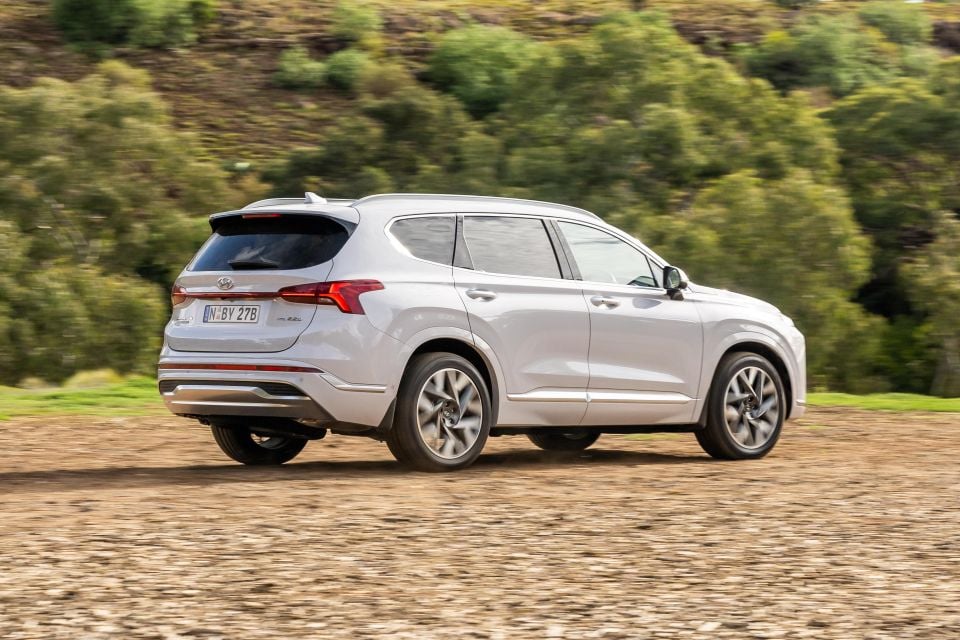
Where expert car reviews meet expert car buying – CarExpert gives you trusted advice, personalised service and real savings on your next new car.
The Santa Fe continues to impress on the open road. With eight gears to choose from and a torquey turbo-diesel, the Hyundai cruises happily spinning well under 2000rpm and lightly sipping on juice.
The ride that errs on firm in town settles beautifully at the national speed limit, and the cabin is pretty well insulated from road and wind noise. I did notice a little bit of tyre roar over coarse-chip bitumen, but it was still muted somewhat.
Highway driving also gave us the best environment to test out the various Hyundai SmartSense assistance features.
The adaptive cruise control and lane centring functions were some of the better calibrated ones I’ve sampled, though many won’t like the constant assistance from the latter.
Highlander grades also get the cool Blind Spot View Monitor projecting live camera feeds from the mirrors in addition to conventional blind-spot monitoring when you indicate. It certainly comes in handy if you’re switching lanes in a rush.


The Santa Fe is covered by a five-year, unlimited-kilometre warranty with lifetime capped-price servicing.
You can purchase a pre-paid servicing plan covering three, four or five years, priced at $1377, $1836 and $2295 respectively for the diesel model we have on test.
Should you opt for the V6 petrol, servicing is more affordable at $1197, $1596 and $1995 for the same intervals.
Maintenance is required every 12 months or 15,000 kilometres, whichever comes first.

If you told most Australian buyers five or 10 years ago you could logically consider a Korean product as an alternative to more premium Euro stuff they’d probably laugh – but this latest Santa Fe truly lives up to this.
The features, levels of technology as well as the on-road comfort and refinement of this flagship Highlander diesel is compelling, and offers much of what premium-badged equivalents do for much less.
Yes, it’s still a lot of money at $70,000 on the road, but the Highlander is a fine example of family-friendly luxury motoring. This and the latest Kia Sorento really are two leaders in the large SUV segment.
Our main gripes would be the tight third row and lack of full curtain airbag coverage, as well as the desire (not necessity) for a more powerful diesel.
Beyond that, there’s not much to complain about.

Click the images for the full gallery
MORE: Hyundai Santa Fe news, reviews, comparisons and videos
Where expert car reviews meet expert car buying – CarExpert gives you trusted advice, personalised service and real savings on your next new car.
James Wong is an automotive journalist and former PR consultant, recognised among Australia’s most prolific motoring writers.


William Stopford
10 Days Ago


Matt Campbell
18 Days Ago


Damion Smy
18 Days Ago


Damion Smy
23 Days Ago


Paul Maric
29 Days Ago
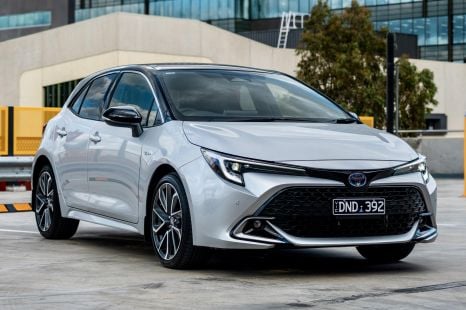

Max Davies
1 Month Ago